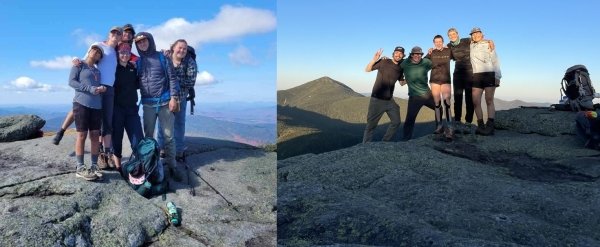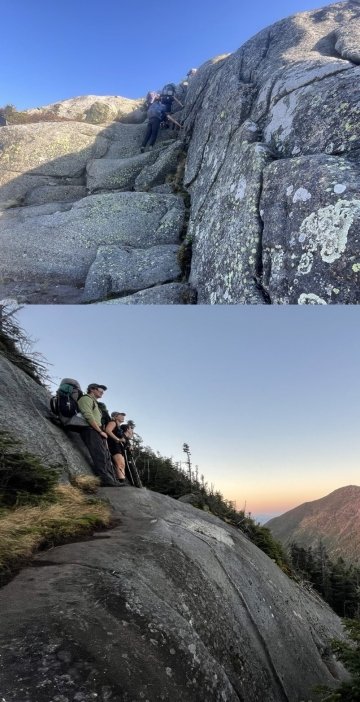
Our Sick Climbing Adventure
Meg Costin-Shaw & Campbell Jenkins
September 22, 2023

On the dawn of a foggy September morning, twelve Arcadians pile into a classic St. Lawrence University van, beginning their trek to the North Country School’s private rock-climbing crag. With Sam in the driver’s seat and Simon and Garfunkel blaring through the speakers, a barrage of coughs and sneezes accompany the innocent tunes. Over the past few weeks, we Arcadians have been getting exponentially sicker, and this week is the peak of our communal illness. Despite one Arcadian’s concussion, another’s occasional uncontrolled loss of consciousness, and our never-ending battle against sinusitis and the common cold, we have yet to face our sickest conquest yet: the gnarly climbing routes set by our student guides Brynn, Finn, and Tony.
We begin our day with a tour of the school’s campus by Todd, a St. Lawrence University alum, and John Bernhardt, a former Arcadian and current North Country School academic intern. With our tour guides’ collective knowledge, we glean a holistic image of the school’s values and mission. By prioritizing the process over the outcome, meeting kids where they are, and fostering a sense of community, the school enables kids to flourish while embracing their individuality. Many of us have come from more traditional backgrounds in education, so it is refreshing to witness the values we practice in Arcadia implemented on a larger scale. Seeing this school with its lush gardens, speedy slides, and overall gorgeous campus, we feel a sense of gratitude that we carry with us throughout our day at the North Country school’s private crag.

After our lovely tour, we set off to the crag with Eva in the lead. We bound up the hill in various footwear, including Crocs and hiking boots. As we turn the corner to the glorious crag illuminated by the sun, we practice our SLU bird-mating call (“Hey St. Lawrence! Hey, hey, hey St. Lawrence!”) with the goal of calling our guides from their roost perched on top of the crag. Our Ornithology professor Sue Willson would be proud. In response to our call, one by one, Brynn, Finn, and Tony descend the wall, creating a showstopping entrance that could only be topped with a fog machine, confetti, and an entire Broadway stage crew. They brief us on the rock-climbing basics, and we begin our sickest adventure yet.
As our fellow Arcadians attempt to scale the wall, unique styles appear. Abhainn seems to fall into the splits at every opportunity, and playing possum, Sam’s limp body is lowered slowly but surely to the ground by our fearless belayer Callie. Darlenne conquers the wall like an apex predator, and no one is surprised when Arianna floats effortlessly up the wall in her Carhartt overalls to where Eva gazes over us like a stoic watchful hawk.
Over the semester we have begun to form our own culture founded on our shared experiences. Not only do we have inside jokes, songs, and unique forms of appreciations, but we also share a communal “weird,” which reflects how close we’ve gotten and our ability to embrace our most authentic selves. Our guide Finn, who completed the Adirondack Semester last year, says that he wanted to see how weird we had gotten and claims that we exceeded his expectations within the first five minutes of being here. Often, when an outside person enters our sweet Arcadian bubble, our community’s unique culture is amplified, which might seem weird but also illustrates our closeness.
As things begin to wind down, we can’t help but reflect on our privilege and rare access to this beautiful private crag. Inspired by this reflection, we have a conversation with our guides about rock climbing in the Adirondacks, specifically about accessibility. Even with varied levels of experience, they all agree that the rock-climbing culture in the Adirondacks is notably more inaccessible than other climbing hotspots. Rock climbing is a difficult sport to get into because of the high entry cost of gear and the know-how necessary to stay safe. With the additional obstacles of sandbagging graded roots, rough terrain, and a lack of bolt use, the Adirondacks are extremely inaccessible. (For those unfamiliar with climbing jargon, “sandbagging” is when people say that climbing routes are much easier than
they are, making novice climbers feel inadequate. To say that a route is “bolted” means that there are permanent climbing aids drilled into the rock as an anchor in case a climber falls.) We then ask our guides if they think that Adirondack climbing should be more accessible even though more access means more people, less solitude, and the potential for environmental destruction. In response, all three agree that certain routes should be made more accessible to get more people climbing and excited about the land, but they also note that they want to keep some routes the same to preserve the traditional values of the Adirondack climbing community.
With sore hands, scraped knees, and an enlightening conversation with our guides behind us, we are ready to head back to Arcadia, eat a pancake dinner to warm our bellies, then slide into comfy sleeping bags to snuggle up for the night. On our drive home, we reflect on our adventurous day. From learning about the happenings on campus, the aliens in Mexico, and the insane discovery of the common polypody on the rock face, we are pretty content. As the week progresses, our sicknesses remain, but we get new mullets, a deeper understanding of our lake, and a class where we literally roll in the mud, and along the way, we think back to our rock-climbing adventure at the North Country School, which reminds us why we are here. We are here to live in a community of intention and grow in character alongside our ferns—I mean, our friends.
